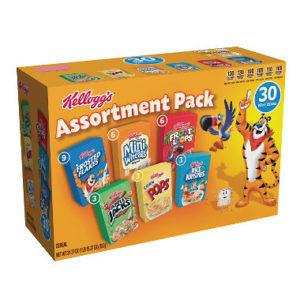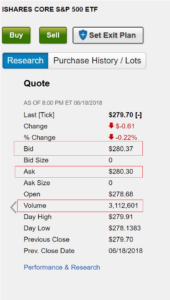The cereal aisle is possibly one of the best grocery store locations. Those colorful rectangular boxes all lined up so neatly, promising mouth-watering delight and childhood nostalgia in one sugary bite.
Shopping for ETFs is not quite as magical. Can you eat an ETF? Uh, sadly no. #foodislife
But there are over 1,700 exchange-traded funds in the US market. Which can make purchase decisions overwhelming – not far off from how the cereal aisle feels. Since ETFs are significantly more expensive and impactful to your financial health, it’s an investment decision that should be taken with care.
Here are five things to ask yourself before buying an ETF.
1. What am I buying?
Sorry, but the answer is not, “An ETF.”
What this question really means: Do you understand all the securities that make up the ETF you’re considering? If you were buying cereal, you’d read about the flavors and ingredients. This is the same idea.
On your brokerage website, you can view a full list of all the securities that make up the ETF and each holding’s percentage of the pie. In most cases, the holdings will be stocks. Understand the different companies, industries, and sectors those stocks represent before you give the ETF a green light. You don’t have to read the financial statements or 10-K of each. Just get a general idea.
Basically, make sure you’re following the rule “buy what you understand.”
2. Why am I buying?
If the ETF covers a specific sector or geography, know why you want to invest in that area. This “investment thesis” can be as simple as one sentence. Write it down or tell it to a friend or family member. Talk to people who love a good debate. It might be annoying, but it helps redirect undercooked ideas. Don’t have investment-minded friends or family to talk to? Comment your ideas below and we’ll be your devil’s advocate.
If you’re starting from scratch, a diversified ETFs might be a good place to start. Think of this like those after-school snack packs of different cereals. Variety in a box.
Diversified ETFs can provide exposure to a range of industries. Even if you’re diversified, however, it’s still important to have an investment thesis. For example, if you are considering an S&P 500 index ETF, identify your opinion on the market. Is your outlook positive? Why?
These aren’t easy questions to answer, and it’s ok to get outside help to formulate your opinion. The key action to take is educating yourself about the market and world around you by reading financial, national and world news.
3. Does this ETF suit my portfolio and risk tolerance?
Find suitable investments for your risk tolerance like you would buy a cereal that matches your nutrition goals. If you were trying to cut down on sugar, you would look to buy cereals like these.
For investment risk tolerance, think about what securities you already own, your investment goals, and how much stability you need from your returns. An ETF you buy should match, compliment, or hedge (protect against downfall) the other assets you own.
Once you’ve answered question 1 from this list, you’ll know the ETF’s sector exposure. Research the ETF’s historical performance and the performance of its major holdings.
For ETFs and stocks, more volatility does not necessarily mean greater risk, but it could indicate how the market views the securities. (For further reading about risk and volatility, check this article out.)
4. Is the ETF liquid?
Liquidity is how easily something can be bought and sold. Your old couch that took three weeks on Facebook marketplace to sell? Not super liquid. However, in a different city or market, liquidity might have been better. The same goes for securities.
On a related cereal/liquidity note, this blog forum is dedicated to people selling old cereal boxes. There’s a market for everything if you look hard enough!
The more liquid a security or good is, the tighter the buying-selling price. In security land, this is called the bid-ask price.
Bid = how much you pay to buy
Ask = how much you’ll receive if you sell
If you’re planning to hold an ETF for a longer period, liquidity matters less. However, it still indicates the demand and popularity of the security.
An illiquid ETF might indicate a smaller player that isn’t worth your time. To check the liquidity of an ETF, look at the bid-ask spread and the volume of shares traded a day. You can usually find these on a broker’s ETF profile page. Below is a quick rundown of the iShares Core S&P 500 ETF, aka the IVV. Below the bid-ask prices and the daily trading volume are circled.
5. How much does it cost?
The cost of an ETF has multiple components to consider. (For an overview of all ETF costs, read this.)
1. Actual price per share
2. Expense ratio
3. Any additional purchase fees, redemption fees, and commissions.
You can see above, one share of the IVV is marked at $279.70. However, as a buyer, you will pay something closer to the bid price of $280.37. The IVV ETF is a commission-free purchase on Fidelity’s website.
The more you can avoid commission and other fees, the more money you’ll save. If you plan to only hold the investment for a short time, make sure to understand the penalty fees that may be associated with shorter-term holds.
As previously mentioned, there are lots of ETFs out there. Check if the exposure you’re looking for could be accomplished with a different ETF that has cheaper overall costs. Like swapping Kellogg Rice Krispies for the store brand’s version.
RECAP
Before you click “buy” on an ETF purchase, ask yourself the what, why, and how much questions. Acknowledge your comprehension level of the ETF’s holdings. Look up the ETF’s daily volume, bid-ask price, and fees. Decide if the ETF compliments the other investments you already hold. Is there a different ETF that will accomplish the same objective for a cheaper price?
It can be easy to buy investments without thinking much first. But doing some research and analysis beforehand will help you make informed investment decisions now and later. The trick is to not get stuck in analysis paralysis.
Pro-tip: while you analyze, munch on a bowl of your favorite cereal.





